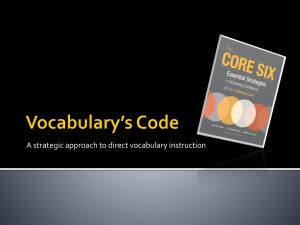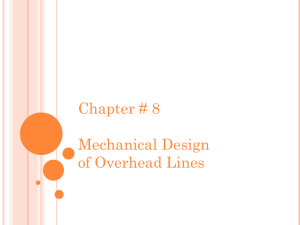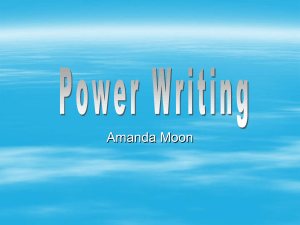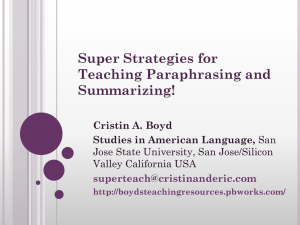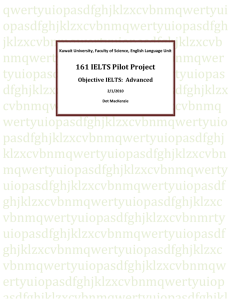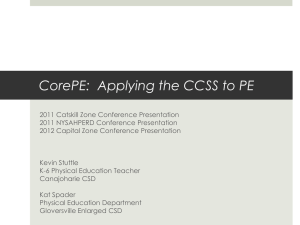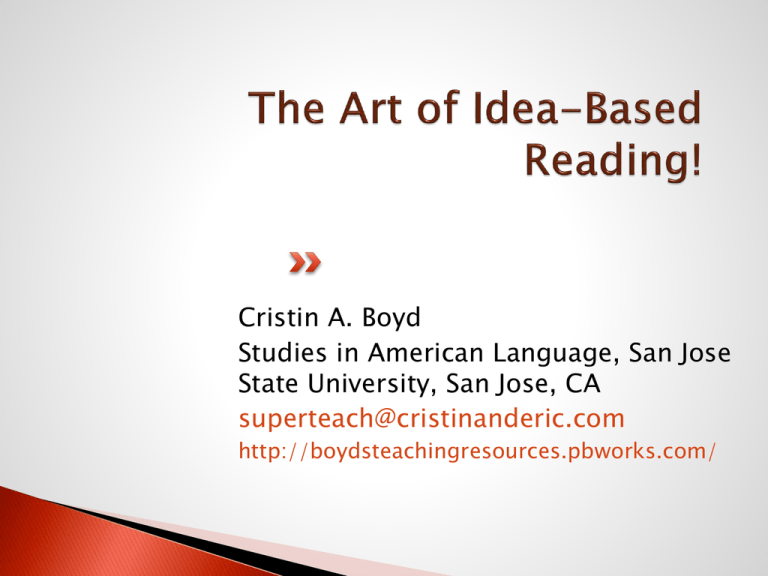
Cristin A. Boyd
Studies in American Language, San Jose
State University, San Jose, CA
superteach@cristinanderic.com
http://boydsteachingresources.pbworks.com/
18 years teaching experience
Stilted reading skills at higher levels (highintermediate/advanced IEP)
Concepts/ideas based mainly on classroom
experience
Evidence of S improvement
◦
◦
◦
◦
In class practice
On exams
Comments from Ss
Increased TOEFL (iBT and PB) scores
These skills are for high-int/advd readers
Limited time w/ Ss; main skills I focus on
www.boydsteachingresources.pbworks.com
Get side-tracked with individual words?
Misunderstand small & large portions of what
they read?
Miss key ideas and concepts?
Take hoooooours to read something that
should take 20 minutes?
Insist on understanding e-v-e-r-y w-o-r-d?
Cling too tightly to translators?
www.boydsteachingresources.pbworks.com
Very strong desire to understand everything
Words are tangible; ideas often elusive
Native country/culture learning/experience
Math-like learning of language
Bottom-up processing
Heavy focus on vocabulary
Limited T proficiency
Limited reading resources
◦ Memorization-focused learning
◦ Reader responsible backgrounds
◦
◦
◦
◦
Word/character-focused L1 (example)
www.boydsteachingresources.pbworks.com
mu ('tree') shows a trunk and two leafless branches of a
tree. The bottom half of the character may be hanging
branches or the roots of a tree .… the character doubles
to represent "forest" and triples to represent "dense
forest." It joins with the character for "person" to
represent "rest,” . . .
mo ('last' or 'top') shows a tree in which the top is marked
with a horizontal stroke, while
ben ('source' or 'origin') shows a tree in which the root is
marked with a horizontal stroke.
Relationships between characters complex also
From:
http://www.mmtaylor.net/Literacy_Book/DOCS/pt1.htm
l
Low-level reading/learning
◦
◦
◦
◦
◦
Translation
Intensive rather than extensive reading
Vocabulary words, definitions, meaning, exams
Limited real-life reading practice
Vocabulary learning (vs. acquisition)
Grammar, sentence structure, vocabulary all
focus on words
www.boydsteachingresources.pbworks.com
WHY
IS WORD-LEVEL FOCUS PROBLEMATIC
FOR HIGHER LEVEL READERS?
English meaning is not word-based
Meaning is found in . . .
collections of words (groups of sentences
and paragraphs)
-- “discourse blocks” (Christensen 1963,
Pitkin 1969)
-- paragraphs (Kaplan 1972)
--
What are the parts & functions of a paragraph?
www.boydsteachingresources.pbworks.com
•
•
•
Fluent readers read quickly & efficiently
They do not focus intensively on words
They expect & focus on ideas
www.boydsteachingresources.pbworks.com
“. . . students need to learn to read,
think and interpret text in news
ways”
-B.
Mikulecky, co-author of Reading Power Series
One fundamental ‘new way’ is ideafocused reading
www.boydsteachingresources.pbworks.com
Focusing on ideas
◦ Rhetorical features
◦ Expectations
Not reading every
word
Using context to
understand
vocabulary
Reading faster &
more efficiently
Reading through
Ambiguity
Embracing a new
“western style”
approach to
reading
(not a complete list)
www.boydsteachingresources.pbworks.com
Purpose: Review higher level reading skills;
Help socialize Ss to new reading style
www.boydsteachingresources.pbworks.com
Everything…. But in particular
Focus on main ideas
Reading faster
Not reading every word
Ambiguity Tolerance
◦ Understanding concept
◦ Understanding self
◦ Changing reading style
www.boydsteachingresources.pbworks.com
Skill: main idea reading, faster reading
www.boydsteachingresources.pbworks.com
Lecture/discussion format
Review parts of a paragraph/emphasis on
main idea
◦
◦
◦
◦
◦
What are the parts of a paragraph?
What does a topic sentence DO?
Supporting sentences?
Conclusion?
What other things make a good paragraph?
Coherence: repeated key words
◦ Do all these apply to an essay, article, chapter?
Good readers expect paragraphs to be
about one idea!
www.boydsteachingresources.pbworks.com
Skills: faster reading, focusing on main ideas,
not focusing on words
www.boydsteachingresources.pbworks.com
Skills: not reading every
word; using context
Short reading time =
increased speed
www.boydsteachingresources.pbworks.com
Skill: use of context to understand vocabulary;
not use dictionaries or translation
www.boydsteachingresources.pbworks.com
Lots of opportunities to practice
“western style” Reading (in class and out)
www.boydsteachingresources.pbworks.com
A Short Course in Teaching
Reading 2e by B. Mikulecky
(2011) Pearson-Longman
www.boydsteachingresources.pbworks.com

